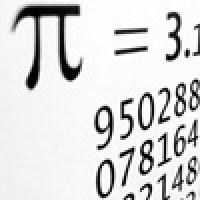
Computer geeks break Pi record

Two computer geeks claim to have calculated the number pi to 5 trillion places, on a single desktop and in record time. That's 2.3 trillion digits more than the previous world record held by the Frenchman Fabrice Bellard. Japanese system engineer Shigeru Kondo and American student Alexander Yee achieved the result using a program created by Yee and a desktop computer built by Kondo. The program took 90 days to compute the 5 trillion digits and over 60 hours to verify the result.
The number Pi has an infinitely long decimal expansion which never repeats (unlike the expansion of a rational number like, say, 1/3=0.33333.....) and contains no discernible patterns. In fact, many mathematicians believe that the expansion of Pi is an example of perfect randomness, exhibiting the same statistical properties as a sequence you'd get by throwing a perfect 10-sided die infinitely many times. So if you want to know what the 5 trillionth digit is, all you can do is sit down and calculate it.
What you do with this 5 trillionth digit is another matter. Real-life applications require an accuracy of at most a few tens of digits and from a mathematical viewpoint the actual digits of pi are nowhere near as interesting as its number theoretical properties, or the statistical properties of its expansion. But Kondo and Yee's interest was to do with computers, rather than maths "After Fabrice Bellard's announcement of 2.7 trillion digits on a relatively 'cheap' desktop, it was pretty clear that the limit of personal computing was a lot higher," Yee says on their website. "Shigeru Kondo and I wanted to see how much better we could do if we used some more powerful hardware. Both of us are hardware fanatics. And both of us (especially Shigeru Kondo) had some very powerful machines at our disposal. So with that, we decided to see how far we could push the limits of personal computing using personally owned hardware."
The computer built by Kondo for the purpose may be called "personal", but it's got nothing to do with what you and I have sitting around at home or in the office. With 96 GB of RAM and over 39 TB of disc storage, it massively outstrips any ordinary machine. Roughly 22 TB of disc was needed to perform the computation.
The algorithm used to calculate the digits of Pi was developed by Yee and, as he claims, also holds the record for digit computations for many other famous constants, including $e$, the golden ratio and the square root of 2. Pi is computed using infinite sums that converge to it. Perhaps the most famous example of such a sum is the Gregory-Leibniz series $$\pi=4(1-1/3+1/5-1/7+1/9-...).$$ As you add more and more terms in this sum, the result does not become arbitrarily large, but gets closer and closer to Pi. This is because successive terms become smaller at a rate that outstrips the growth of the sum.
However, in the case of the Gregory-Leibniz series convergence is painfully slow: you need to compute the first 300 terms to calculate Pi correctly to two decimal places.
Yee's algorithm resorts to another series with faster convergence, known as the Chudnovsky formula:
$$\frac{1}{\pi}=\frac{\sqrt{10005}}{4270934400}\sum_{k=0}^{\infty} (-1)^k\frac{(6k)!}{(k!)^3(3k)!}\frac{(13591409+545140134k)}{640320^{3k}}.$$ Here the symbol $\sum$ stands for summation: the first term of the series has $k=0$, the second $k=1$ and so on, ad infinitum. The exclamation mark stands for factorial: for a whole number $n$, $$n!=n\times (n-1)\times (n-2) ... \times 2 \times 1.$$
Yee then used two further series to verify the result. To find out more, and to see some pictures of Kundo and Yee's personal ubercomputer, have a look at their website.
Comments
Anonymous
The second equal should be a product in the Chudnovsky formula.
Ruben (mostlymaths.net)
Marianne
Ooops, sorry and thanks!
Anonymous
I was just amazed that pi was equal to an algebraic expression :)
Marianne
Ooh, I didn't mean to frighten you!
Anonymous
Maths is my favourite!